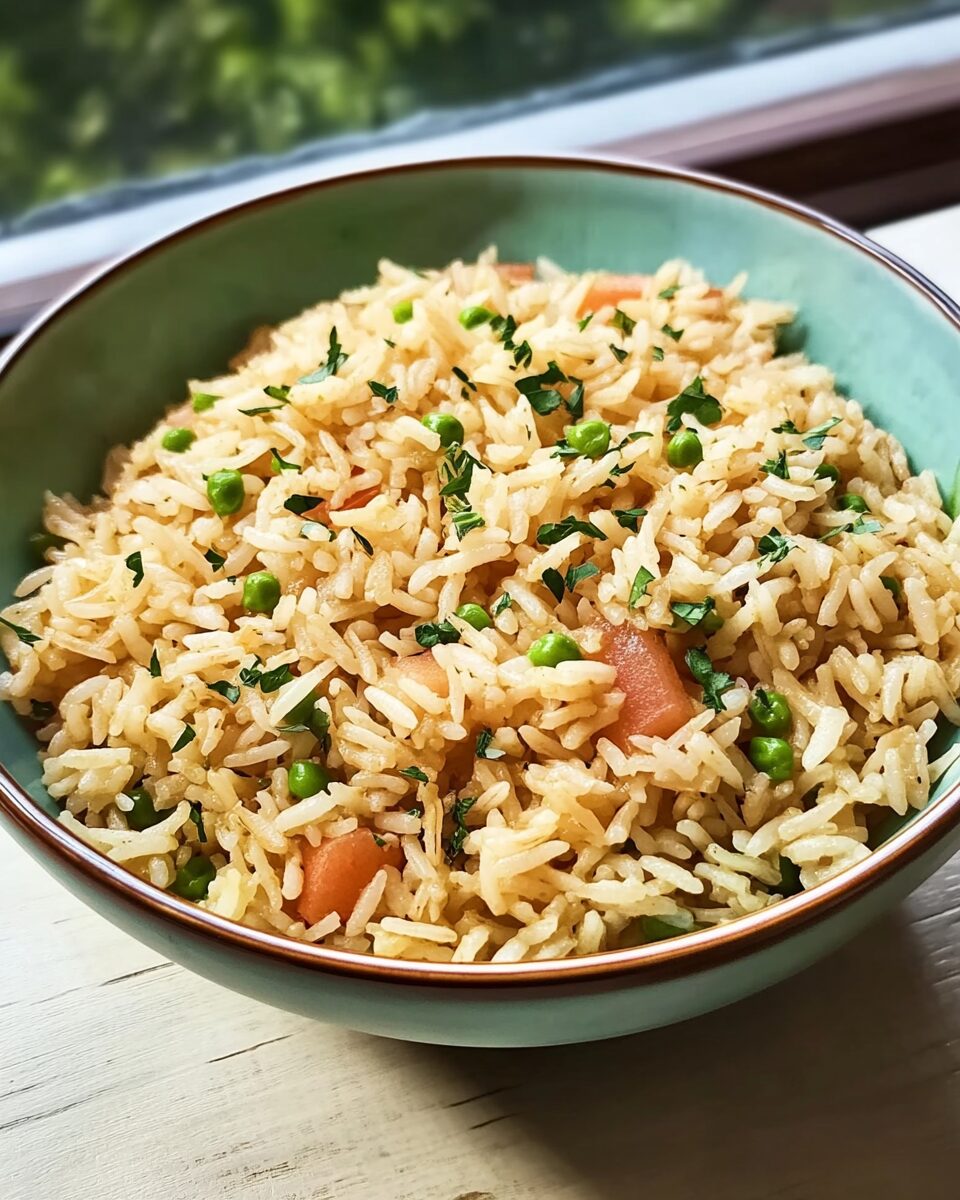Sarah’s Rice Pilaf is a flavorful side dish that combines nutty orzo pasta, aromatic onion and garlic, and white rice, all cooked together in savory chicken broth. This simple yet delicious recipe elevates any meal with its rich taste and satisfying texture.
Full Recipe:
Ingredients
- 2 tablespoons butter
- ½ cup orzo pasta
- ½ cup diced onion
- 2 cloves garlic, minced
- ½ cup uncooked white rice
- 2 cups chicken broth
Directions
-
Melt butter and toast orzo
- In a skillet over medium-low heat, melt the butter. Add the orzo pasta and cook, stirring frequently, until the orzo is golden brown.
-
Add aromatics
- Stir in the diced onion and cook until it becomes translucent. Add the minced garlic and cook for an additional minute.
-
Incorporate rice and broth
- Stir in the uncooked white rice and pour in the chicken broth. Increase the heat to high and bring the mixture to a boil.
-
Simmer
- Once boiling, reduce the heat to medium-low, cover the skillet, and let it simmer until the rice is tender and the liquid has been absorbed, about 20 to 25 minutes.
-
Rest and fluff
- Remove the skillet from the heat and let it stand, covered, for 5 minutes. Fluff the pilaf with a fork before serving.
Nutritional Facts (Per Serving)
- Calories: 244
- Total Fat: 7g
- Saturated Fat: 4g
- Cholesterol: 18mg
- Sodium: 524mg
- Total Carbohydrates: 40g
- Dietary Fiber: 2g
- Total Sugars: 2g
- Protein: 6g
- Vitamin C: 2mg
- Calcium: 20mg
- Iron: 2mg
- Potassium: 100mg
The Origins of Rice Pilaf
Rice pilaf has a long and fascinating history, with its origins tracing back to the Middle East and Central Asia. The word “pilaf” comes from the Persian word “pilāv,” which refers to rice cooked in broth or seasoned liquid. The technique of cooking rice this way spread throughout the world, influencing dishes in the Mediterranean, Indian, and even American cuisines.
The basic concept of pilaf involves sautéing the grains in fat before adding liquid, which helps coat each grain and results in a fluffier texture. This method differentiates pilaf from regular steamed or boiled rice. Over time, different cultures have added their own touches, incorporating various spices, herbs, nuts, and dried fruits to create unique variations.
Sarah’s Rice Pilaf is a simple yet flavorful adaptation of traditional pilaf, using orzo pasta for an added layer of texture. Orzo, a rice-shaped pasta, brings a slight chewiness and nutty depth to the dish, making it stand out from other rice-based recipes.
Why Rice Pilaf is So Popular
There are several reasons why rice pilaf is a favorite among home cooks:
- Easy to Make – While it may sound fancy, pilaf requires only a handful of ingredients and comes together in about 30 minutes.
- More Flavorful Than Plain Rice – Toasting the rice and orzo in butter adds depth, and cooking it in broth enhances the overall taste.
- Pairs Well with Many Dishes – Whether served with roasted chicken, steak, seafood, or vegetarian options, pilaf complements a wide variety of meals.
- Customizable – Different herbs, spices, and ingredients can be added to suit personal preferences or dietary needs.
- Great for Meal Prep – Pilaf stores well and reheats easily, making it a practical choice for busy families.
Different Variations of Rice Pilaf
One of the best things about rice pilaf is that it can be easily adapted to suit different tastes. Here are some variations to try:
- Mediterranean Rice Pilaf – Incorporates ingredients like pine nuts, raisins, and fresh parsley for a bright and slightly sweet flavor.
- Spicy Pilaf – Adding a pinch of cayenne pepper or chili flakes can give the dish a warm, spicy kick.
- Herbed Rice Pilaf – Fresh herbs like thyme, rosemary, or dill can be added for a fragrant and earthy touch.
- Vegetable Pilaf – Diced carrots, peas, and bell peppers provide color and extra nutrients.
- Garlic Butter Pilaf – A richer version with extra garlic and butter for a bold, comforting taste.
- Mushroom Rice Pilaf – Sautéed mushrooms add a deep umami flavor that pairs well with roasted meats.
For those looking for a healthier version, using brown rice instead of white rice and whole-wheat orzo can increase the fiber content while maintaining the dish’s delicious taste.
Tips for Making the Perfect Rice Pilaf
While rice pilaf is relatively simple to prepare, a few tips can help achieve the perfect texture and flavor:
- Toast the Orzo and Rice – This step is crucial for developing a nutty, deep flavor and preventing the rice from becoming mushy.
- Use High-Quality Broth – Chicken broth, vegetable broth, or even homemade stock can enhance the taste of the dish significantly.
- Simmer with the Lid On – Once the liquid is added, keep the lid on to trap steam and allow the rice to cook evenly.
- Fluff with a Fork – Stirring with a spoon can break the rice grains, so it’s best to use a fork to gently separate them before serving.
- Let it Rest – Allowing the pilaf to sit for a few minutes after cooking helps the grains absorb any remaining moisture and prevents clumping.
Serving Suggestions
Sarah’s Rice Pilaf is a versatile dish that works well with many different meals. Here are some ways to serve it:
- With Grilled or Roasted Meats – Chicken, beef, pork, or lamb are all excellent pairings for pilaf.
- Alongside Seafood – Shrimp, salmon, or white fish complement the delicate flavors of the dish.
- As a Side for Vegetarian Meals – Serve pilaf with grilled vegetables, tofu, or a fresh salad.
- In Stuffed Peppers – Use pilaf as a filling for bell peppers for a creative and hearty meal.
- As a Base for a Grain Bowl – Add protein, vegetables, and a drizzle of sauce for a well-balanced meal.
Health Benefits of Rice Pilaf
Beyond its great taste, rice pilaf offers several nutritional benefits:
- Good Source of Energy – Rice and orzo provide carbohydrates that fuel the body.
- Contains Essential Vitamins and Minerals – Onions and garlic contribute antioxidants, while broth adds minerals like potassium and calcium.
- Low in Fat – When made with a moderate amount of butter, pilaf remains a relatively low-fat dish.
- High in Fiber (if using brown rice) – Swapping in whole grains can improve digestion and heart health.
To make a lighter version, consider using olive oil instead of butter and opting for a reduced-sodium broth.
Conclusion
Sarah’s Rice Pilaf is a simple yet elegant side dish that enhances any meal. Its origins in traditional pilaf recipes bring depth and richness, while the use of orzo adds a delightful twist. The dish is easy to prepare, full of flavor, and highly adaptable to different dietary preferences.






